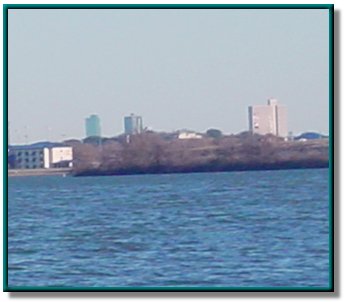Lake Worth Watershed

Photograph courtesy of the
Fort Worth Water Department
County: Tarrant
Parameter: polychlorinated biphenyls (PCBs) in fish tissue
River Basin: Trinity
Segment: 0807, 0808
On this page:
- Background and Goal
- Watershed Description
- Status
- Approved I-Plan
- Adopted TMDL
- Contact the TMDL Program
Background and Goal
In April 2000, the Texas Department of State Health Services (DSHS) issued a fish consumption advisory to protect consumers from adverse health effects caused by accumulation of polychlorinated biphenyls (PCBs) in fish. In advisory ADV-18, the DSHS warned people to limit or stop eating all species of fish caught in the lake. PCBs is a general term used to describe 209 toxic, environmentally persistent compounds.
The goal of this project is to reduce PCBs to levels so that it is safe to eat fish from the lake. TCEQ completed a TMDL project to determine the pollutant limits necessary to restore support of the use. The TMDL defines an environmental target by determining the extent to which a certain pollutant must be reduced in order to attain and maintain the affected use. After completing the TMDL, TCEQ developed an I-Plan with stakeholders to reduce pollutant loads.
Watershed Description
Lake Worth (Segment 0807) is a 3,558-acre impoundment of the West Fork Trinity River, located directly south of Eagle Mountain Reservoir. Although the lake itself is almost entirely within the Fort Worth city limits, the contributing watershed extends 2,064 square miles across Tarrant and Parker counties and includes several other smaller municipalities. The lake has a conservation capacity of approximately 37,000 acre-feet, and drains a 2,064 square-mile watershed.
Lake Worth is used for recreation and is also source of drinking water for the city of Fort Worth. Land use in the watershed is about 35 percent urban and 60 percent rural.
Two large military-industrial facilities are on the south side of the lake—the U.S. Naval Air Station Joint Reserve Base–Fort Worth (NASFW) and Air Force Plant No. 4 (AFP4). Both facilities are currently classified as cleanup sites under the federal Resource Conservation and Recovery Act (RCRA).
Status
The TMDL I-Plan relies heavily on cleanup efforts at Air Force Plant No. 4 (AFP4), located on the south side of the lake. AFP4 is undergoing cleanup under the federal Resource Conservation and Recovery Act (RCRA) program. Also, under the I-Plan, fish tissue in Lake Worth is sampled periodically to monitor the effectiveness of cleanup efforts.
DSHS conducted the first fish tissue monitoring under the I-Plan in October 2008. Based on that monitoring data, DSHS extended the advisory to include Segment 0808. The second fish tissue monitoring effort under the I-Plan was conducted November 2016. In March 2018, DSHS issued advisory ADV-60, limiting consumption of seven fish species due to dioxins and PCBs.
However, the overall mean concentration of PCBs in all fish has declined. The mean concentration for the 80 samples collected in 2008 was 0.064 milligrams per kilogram (mg/kg) PCBs. The mean concentration for the 80 samples collected in 2016 was 0.032 mg/kg PCBs.
Texas DSHS still has a fishing advisory for Lake Worth. Please take a moment to fill out this fish consumption survey to help DSHS better understand and serve the public with relevant information about advisories like this one.
Approved I-Plan
The Commission approved this I-Plan on Aug. 23, 2006.
- I-Plan for One TMDL for Polychlorinated Biphenyls (PCBs) in Fish Tissue in Lake Worth, Segment 0807
- Response to Public Comment on the I-Plan, July 2006
Adopted TMDL
The commission adopted this TMDL on Aug. 10, 2005. The EPA approved it on Oct. 13, 2005, at which time it became part of the state's Water Quality Management Plan.
- One TMDL for Polychlorinated Biphenyls (PCBs) in Fish Tissue in Lake Worth, Segment 0807
- Response to Public Comment on the TMDL June 2005
Revisions to TMDLs
From time to time, it is necessary to revise TMDLs to account for changing conditions in the watershed. Revisions to the load allocations in TMDLs are made via the state’s Water Quality Management Plan (WQMP), which is updated quarterly.
The WQMP provides projected effluent limits for use in planning and permitting activities under the Texas Pollutant Discharge Elimination System (TPDES). The TCEQ reviews all applications for new and amended permits for conformance with applicable portions of the WQMP, including adopted TMDLs.
Addendum
Addenda are created to add load allocations for assessment units that are impaired by the same pollutant or condition, within the same watershed as in the original TMDL report. Addenda use the same units of measure as the original TMDL.
-
TMDL Addendum One: One TMDL for PCBs in Fish Tissue in West Fork Trinity River Below Eagle Mountain Lake
Segment 0808. July 2014 WQMP Update, Approved by EPA November 2014- Assessment Unit 0808_01, July 2014 WQMP Update, Approved by EPA November 2014
Contact the TMDL Program
For further information regarding the TMDLs or I-Plan, please email tmdl@tceq.texas.gov and mention the Lake Worth PCB project in the subject line. Or call us at 512-239-6682.




 Back to top
Back to top